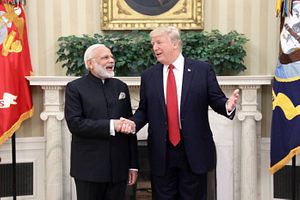In the end, the skeptics were proven wrong as Indian Prime Minister Narendra Modi and U.S. President Donald Trump underlined the strength of the underlying forces that have been bringing New Delhi and Washington closer in recent years during Modi’s visit to the United States this week.
If Modi could argue that India and the United States have overcome “the hesitations of history” under the Obama administration, he effortlessly wooed the Trump Administration when he suggested that “the convergence of my vision for ‘New India’ and President Trump’s vision for making America great again will add new dimensions to our cooperation.” The irksome issues of the Paris climate accord and H-1B visa issues were pushed to the side-lines while the myriad issues on which the two nations strategically converge took center stage.
This was a big win for Modi, make no mistake.
Many in India had started arguing that a transactional Trump would take the sheen off the India-U.S. partnership, one which had been difficult to cultivate and on which Modi himself had expended considerable diplomatic energy since coming to office. But Modi managed to take the visit beyond the sheer symbolism of bear hugs and warm handshakes. He got to know Trump all right, but beyond that he managed to steer Trump towards the larger structural realities that have driven the India-U.S. relationship since George W. Bush declared that America would help India emerge as a global power.
The regional balance of power in Asia was the big focus when Modi and Trump declared their two nations “as responsible stewards in the Indo-Pacific region,” agreeing that a close partnership between the United States and India is central to peace and stability in the region. Without mentioning China, they reiterated “the importance of respecting freedom of navigation, overflight, and commerce throughout the region” and called “upon all nations to resolve territorial and maritime disputes peacefully and in accordance with international law.” What is even more striking is the subtle reference to China’s Belt and Road Initiative when the two leaders talk of “bolstering regional economic connectivity through the transparent development of infrastructure and the use of responsible debt financing practices, while ensuring respect for sovereignty and territorial integrity, the rule of law, and the environment; and call on other nations in the region to adhere to these principles.”
The mention of terrorism was another big win for India. On the one hand, the United States “welcomed further Indian contributions to promote Afghanistan’s democracy, stability, prosperity, and security” while on the other hand the two nations reiterated their commitment “to strengthen cooperation against terrorist threats from groups including Al-Qa’ida, ISIS, Jaish-e-Mohammad, Lashkar-e-Tayyiba, D-Company, and their affiliates.”
The designation of the Hizbul Mujahideen leader Sayeed Salahudeen as a specially designated global terrorist by the United States just before Modi’s visit will be greatly appreciated by New Delhi as it will strengthen its resolve to take on militancy in the Kashmir Valley. India, for its part, joined the United States in expressing concern regarding North Korea’s “destabilizing pursuit of nuclear and ballistic missile programs” and pledged to work together to counter the DPRK’s weapons of mass destruction programs, “including by holding accountable all parties that support these programs.”
Against the backdrop of the sale of Sea Guardian Unmanned Aerial Systems to India, the two nations are now looking to further deepen their defense ties too. From enhancing maritime engagement to expanding collaboration on maritime domain awareness, from India’s support for the United States to join as an Observer in the Indian Ocean Naval Symposium to high-end defense technology transfer, the ambit of the India-US defense relationship is an ever-expanding one.
Modi has time and again made it clear that he recognizes the importance of the United States in meeting India’s developmental and strategic interests. This time too, he underlined that India “considers the U.S. its primary partner for (its) social and economic transformation.” While critics in India will see this as a repudiation of India’s non-aligned foreign policy posture, Modi has no hesitation in proclaiming the obvious without the diffidence of the past governments.
He is at the zenith of his popularity in India and this allows him to take foreign policy risks. Embracing the U.S. wholeheartedly, as Modi has done during his last three years in office, is still a considerable political risk in India. But that’s the road Modi is willing to traverse. From Obama to Trump, it has been a long road, but Modi’s success lies in making the journey fruitful for both sides even as the destination remains firmly in sight.
































